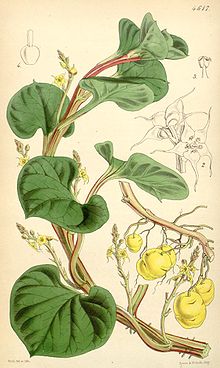| Ulluco | |
|---|---|
 | |
| Scientific classification | |
| Kingdom: | Plantae |
| (unranked): | Angiosperms |
| (unranked): | Eudicots |
| (unranked): | Core eudicots |
| Order: | Caryophyllales |
| Family: | Basellaceae |
| Genus: | Ullucus |
| Species: | U. tuberosus |
| Binomial name | |
| Ullucus tuberosus Caldas | |
The ulluco is one of the most widely grown and economically important root crops in the Andean region of South America, second only to the potato. It is known there with the common name of papa lisa, but also by the regional names melloco (Ecuador), olluco (Peru), chugua (Colombia) or ruba (Venezuela), among others [1]. The leaf and the tuber are edible, similar to spinach and the potato, respectively. They are known to contain high levels of protein, calcium, and carotene. Papalisa were used by the Incas prior to arrival of Europeans in South America.
Contents
|
Usage
The major appeal of the ulluco is its crisp texture which, like the jicama, remains even when cooked. Because of its high water content, the ulloco is not suitable for frying or baking but it can be cooked in many other ways like the potato. In the pickled form, it is added to hot sauces. It is a basic ingredient together with the cubio in the typical Colombian dish cocido boyacense. They are generally cut into thin strips.Oblong and thinly shaped, they grow to be only a few inches long. Varying in color, papalisa tubers may be orange/yellow in color with red/pink/purple freckles. In Bolivia, they grow to be very colorful and decorative, though with their sweet and unique flavor they are rarely used for decoration. When boiled or broiled they remain moist and the texture and flavor are very similar to the meat of the boiled peanut without the skin but unlike the boiled peanut becoming soft and mushy the olluco remains firm and almost crunchy.

No comments:
Post a Comment